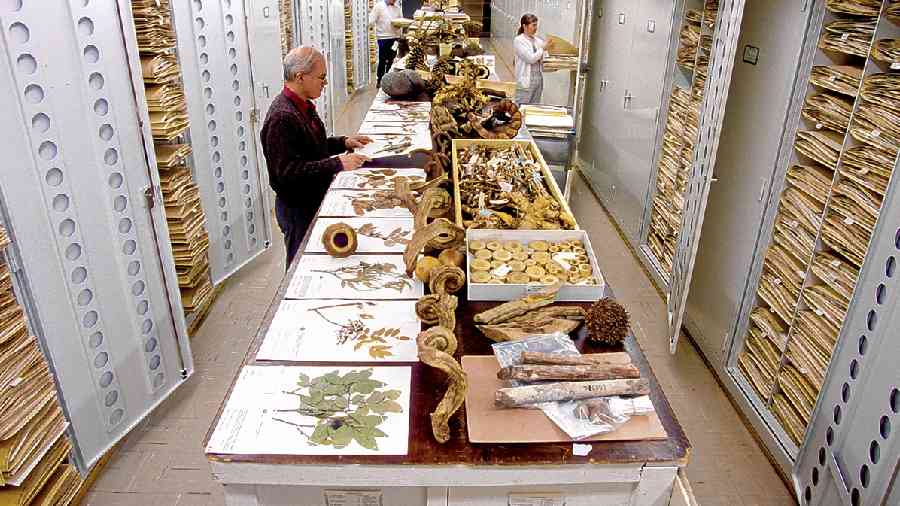Dozens of the world’s largest natural history museums recently revealed a survey of everything in their collections. The global inventory is made up of 1.1 billion objects that range from dinosaur skulls to pollen grains to mosquitoes.
The survey’s organisers, who described the effort in Science, said they hoped the survey would help museums join forces to answer pressing questions, such as how quickly species are becoming extinct and how climate change is altering the natural world.
“It gives us intelligence now to start thinking about things that museums can do together that we wouldn’t have conceived of before,” said Kirk Johnson, who is the director of the Smithsonian National Museum of Natural History in Washington, US, and one of the leaders of the project. “It’s the argument for networking the global museum.”
Scientists had created smaller inventory databases before. But the new effort, which included 73 museums in 28 countries, was unparalleled, experts said.
“The analysis is at a global scale that no one else has managed,” said Emily Meineke, an entomologist at the University of California, Davis, US, who was not involved in the survey.
The survey revealed important gaps in the world’s collections. Relatively few objects come from the regions around Earth’s poles, which are especially vulnerable to the impact of global warming, for example. Insects, the most diverse group of animal species, were also underrepresented.
Meineke said this survey of large institutions also laid the groundwork for surveys of smaller ones, which might hold even more surprises. “Once these methods are applied down the line to smaller collections, the results are likely to give us a truer picture of biodiversity globally,” she said.
Natural history museums got their start in the 1400s as cabinets of wonders in which aristocrats kept precious oddities such as narwhal skulls or glittering crystals. By the 19th century, they had become national institutions that employed cadres of full-time curators.
When a museum gained a new object in those early days, curators would typically scrawl down some basic information about it on a paper slip. That slip might then get tucked into a box of pinned butterflies, or dropped into a jar holding a preserved shark. Curators would then store the box or the jar in a cabinet and make a note of it in a ledger.

Scientists examine plants stored at the National Museum of Natural History in Washington, US NYTNS
Today, natural museums have amassed vast collections. The Smithsonian Museum of Natural History alone holds 14,80,33,146 objects. In recent years, some of these museums have been putting their objects online.
Last year, for example, the US National Herbarium finished uploading photos of nearly 4 million pressed plants. But most objects in natural history museums have yet to be scanned and uploaded to the cloud — or even recorded in an online catalogue.
With only a rough idea of what was in their own collections, Johnson and fellow museum directors recognised they had an even murkier understanding of what they shared collectively.
“It occurred to us that we each hold these amazing assets, but we don’t have a way to compare them,” he said. “We realised that we were presiding over these kingdoms of dark data.”
Rather than wait for years until they had all digitised their collections, the museum directors wanted to take stock now. They asked their curators to fill out a survey describing what kind of collections they housed in their museums — plants, fungi, fossils and so on. They then estimated how big each collection was, sometimes simply by counting cabinets, and where scientists had gone to collect the objects they contained.
The curators also provided the number of objects that had been digitised, how many had been sampled for DNA and how many people had studied different groups of species at each museum. The museums created an online dashboard to explore the survey’s results.
“This is the realisation of a dream I and other people in my role have had for many years,” said Michael Novacek, senior vice-president for science at the American Museum of Natural History in New York City.
Johnson said it was surprising just how many scientists studied mammals compared with other species. “The pull of the warm fuzzy things was pretty apparent in the numbers,” he said.
By contrast, only about 10 per cent of the museum scientists studied insects. “This is kind of a deficit,” Johnson said. “Insects are the biggest component of terrestrial biodiversity, and also huge pollinators and vectors of disease.”
Museums have done relatively little collecting in the Arctic or Antarctica, two regions that are getting hit especially hard by global warming. Novacek said it was important for museums to have a record of the diversity of life there to understand how it was changing with rising temperatures. “It’s a call to action,” he said.
Knowing what is missing from the museums could help them plan new expeditions that can fill in the gaps. “We might be able to make a collecting plan for the 21st century,” Johnson said.
NYTNS










